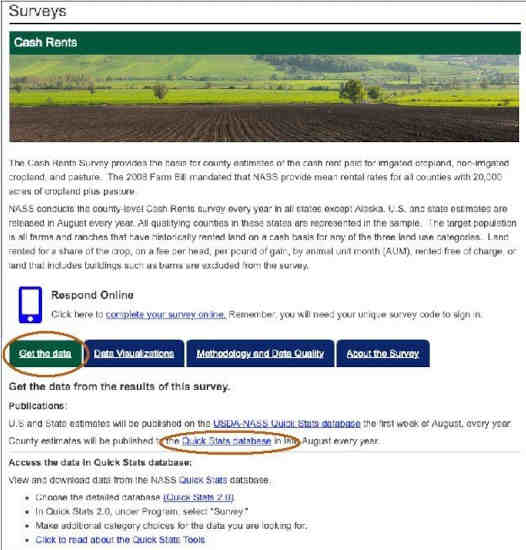By Adriana Murillo-WIilliams
The USDA-NASS Cash Rents Survey provides county-level cash rent estimates for cropland and pastures.
Every year the National Agricultural Statistics Service (NASS) conducts a state-wide survey to estimate cash rent paid for agricultural land. The survey includes farms and ranches with $1000 or more in agricultural sales and have a history of renting land on a cash basis. Results from the survey are published every year in August and provide a basis for county-level estimates of the cash rent that was paid for non-irrigated cropland, irrigated cropland, and permanent pastureland. It is clearly stated in the USDA-NASS website that the survey does not include land with buildings/barns, land rented for a share of the crop, on a fee per head, per pound of gain, by animal unit month, and rented free of charge.
The information can be found on the USDA-NASS Cash Rents website. To access the spreadsheet with the county-based data, go to “Get the data” and then to “Quick Stats database” (Figure 1)

Figure 1. County-based data on cash rental is available in the USDA-NASS website under “Get the data” and “Quick Stats database” (orange circles).
Cash rent estimates are reported in $ per acre, and information is available from 2008 to 2014, and from 2016 to 2020. An easy way to find Pennsylvania’s cash rent data is to download the datasheet and use Excel to create filters.
Details on data collection, how data and outliers were handled, sample size, response rates, and coefficients of variation can be found in the section “Methodology and Data Quality”. For example, the sample size for Pennsylvania in 2020 was 5518 farms, and the response rate was 64%, down from 69.3% in 2019. The number of farmers that responded the survey each year per county is not available on the website.
Cash rents can be quite variable within the state, within a county, within a town, and even among farms along the same road. Each cropland or pastureland has its unique characteristics that can lead to very contrasting rental rates, including soil types, average yields, access to water, previous crops, prevalent weeds, among many other factors that should be considered before signing a lease . In addition, stay informed on what others are charging, market prices for agricultural products, and other external factors that may impact cash rental rates. Additional information and resources can be found in the article “ Owning and Leasing Agricultural Real Estate ”.
Source : psu.edu